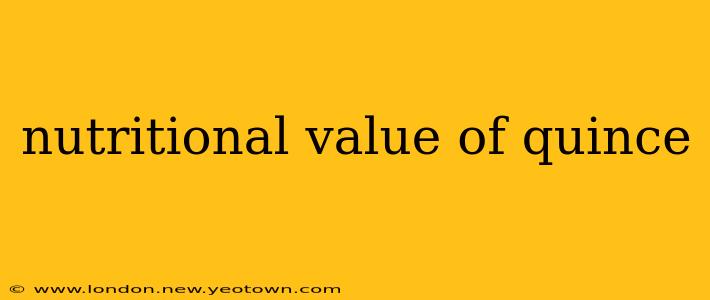The quince, a fragrant, golden-hued fruit with a history as rich as its aroma, often sits overlooked in the modern fruit bowl. But this ancient fruit, prized for centuries for its unique flavor and medicinal properties, deserves a closer look. Its slightly tart and aromatic flesh hides a surprising array of nutritional benefits, making it a worthy addition to a healthy diet. Let's peel back the layers and explore the nutritional value of quince.
What are the main nutrients found in quince?
Quince, surprisingly, isn't just about flavor; it packs a nutritious punch. A single medium-sized quince offers a good source of dietary fiber, vitamin C, and various antioxidants. It's also a decent source of potassium, and contains smaller amounts of other vitamins and minerals like vitamin B6 and folate. The exact nutritional content can vary depending on factors like the variety of quince and growing conditions, but the overall profile remains consistently beneficial. Think of it as a subtle powerhouse of nutrients, gently contributing to your overall well-being.
Is quince good for weight loss?
The high fiber content in quince is a significant boon for those watching their weight. Fiber promotes satiety, keeping you feeling fuller for longer and potentially reducing overall calorie intake. Furthermore, the low glycemic index of quince means it doesn't cause a rapid spike in blood sugar levels, preventing those energy crashes that often lead to unhealthy snacking. While quince alone won't magically melt away pounds, incorporating it into a balanced diet and exercise plan can certainly contribute to healthy weight management.
What are the health benefits of quince?
The benefits of quince extend beyond weight management. Its antioxidant properties contribute to overall health by protecting cells from damage caused by free radicals. Some studies suggest that the compounds in quince may have anti-inflammatory and even anticancer effects, though more research is needed to confirm these promising possibilities. The high fiber content also aids in digestive health, preventing constipation and promoting a healthy gut microbiome. This contributes to better nutrient absorption and a stronger immune system.
How many calories are in a quince?
A medium-sized quince typically contains around 100 calories, a relatively low number compared to many other fruits. This low calorie count, combined with its high fiber and nutrient content, makes it an excellent choice for those seeking a healthy and satisfying snack or addition to their meals. Remember, always check the specific nutritional information for the quince you’re consuming, as variations can exist.
What are the benefits of quince for skin?
Anecdotal evidence and traditional uses point to quince’s potential benefits for skin health. Its rich antioxidant profile could help protect against damage caused by UV radiation and environmental pollutants. Some believe its application topically might help with certain skin conditions, though scientific backing for this is still limited and further research is needed. Its consumption, however, undeniably contributes to healthy skin from the inside out thanks to its vitamin and antioxidant content.
Conclusion: A Fruit Worth Rediscovering
The quince, often overlooked, is a fruit deserving of a prominent place in your diet. From its modest calorie count and high fiber content to its impressive array of vitamins, minerals, and antioxidants, quince offers a unique blend of nutritional benefits. While further research is needed to fully explore its potential health impacts, the evidence so far suggests that incorporating this fascinating fruit into your daily life is a delicious and healthy decision. So, next time you're at the market, don't hesitate to give this historical fruit a try; your body will thank you.

